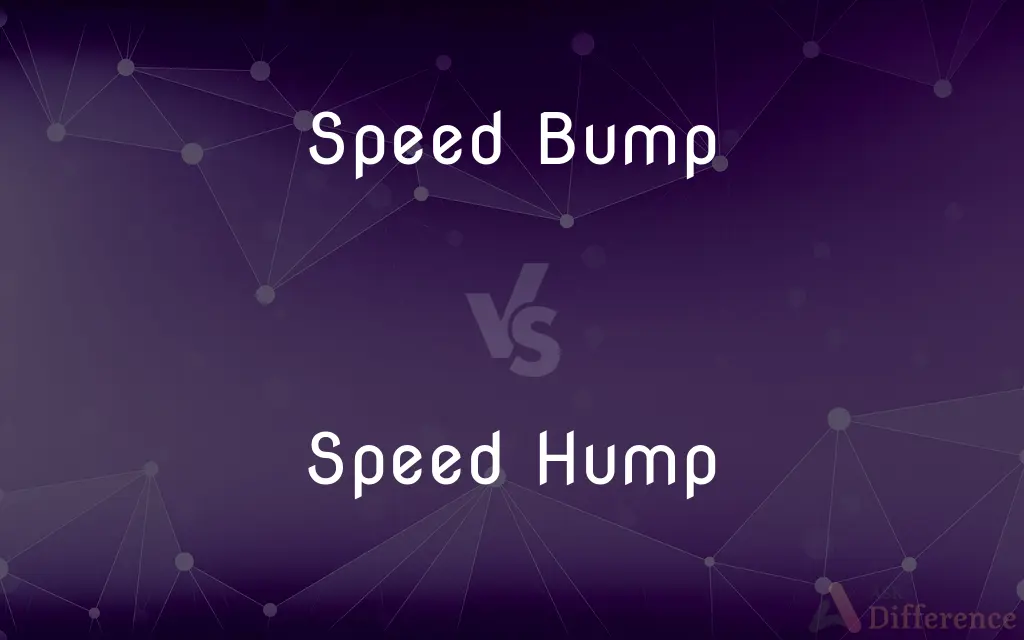Speed Bump vs. Speed Hump — What's the Difference?
Edited by Tayyaba Rehman — By Maham Liaqat — Published on March 3, 2024
Speed bumps are abrupt traffic calming devices designed for low-speed areas, typically causing a more immediate reduction in speed. Speed humps are broader and more gradual, suitable for higher-speed roads, inducing a gentler deceleration.

Difference Between Speed Bump and Speed Hump
Table of Contents
ADVERTISEMENT
Key Differences
Speed bumps are engineered to enforce very low-speed travel, making them ideal for parking lots and private roads. They are shorter in length and have a more aggressive design. In contrast, speed humps are designed to be traversed at slightly higher speeds, suitable for residential streets, as they are wider and have a more gradual incline.
The abruptness of a speed bump can cause significant discomfort if crossed at too high a speed, encouraging drivers to slow down to avoid damage to their vehicle. Speed humps, while still effective at reducing vehicle speeds, are less aggressive, allowing vehicles to pass over them more comfortably at the designed speed limit.
Installation locations differ, with speed bumps commonly found in environments requiring very low speeds, such as near schools and in parking lots. Speed humps are often installed on public roads where maintaining slower, but not minimal, traffic flow is desired.
The impact on emergency vehicles is also a consideration. Speed bumps can significantly slow down response times, while speed humps are designed to have a less detrimental effect, allowing such vehicles to pass over them with less disruption to speed.
Community preferences play a role in the choice between the two. Residents may prefer speed humps on their streets for safety without the severe disruption caused by speed bumps. Conversely, property owners may opt for speed bumps to enforce strict speed limits within confined areas.
ADVERTISEMENT
Comparison Chart
Design
Abrupt, high-angle
Gradual, low-angle
Length
Short (typically 1 to 3 feet)
Longer (typically 10 to 14 feet)
Preferred Speed
5-10 mph
15-20 mph
Installation Location
Parking lots, private roads
Residential streets, public roads
Impact on Vehicles
Causes significant deceleration
Allows for smoother deceleration
Compare with Definitions
Speed Bump
Typically made of asphalt, concrete, or rubber.
The new rubber speed bumps can be removed in winter for snow plowing.
Speed Hump
Designed for slightly higher speeds than speed bumps.
Speed humps allow for a smoother ride at 15 mph.
Speed Bump
Can be a nuisance for emergency vehicles.
The ambulance drivers complained about the speed bumps delaying their response time.
Speed Hump
A broad, rounded traffic calming feature.
The neighborhood installed speed humps to reduce through traffic.
Speed Bump
A small raised area designed to make drivers slow down.
The grocery store parking lot has several speed bumps to ensure pedestrian safety.
Speed Hump
Less disruptive to emergency vehicles.
Fire trucks can cross speed humps without much delay.
Speed Bump
Causes immediate vehicle deceleration.
You'll need to slow down significantly to cross the speed bump without damaging your car.
Speed Hump
Made from similar materials as speed bumps.
The city's speed humps are made of durable concrete to withstand heavy traffic.
Speed Bump
Often found in low-speed environments.
Speed bumps in the school zone keep children safe.
Speed Hump
Preferred on residential streets.
Residents voted for speed humps to keep the streets safe for kids.
Common Curiosities
What is the main purpose of a speed bump?
To enforce very low-speed travel and enhance safety in high-pedestrian areas.
Can speed bumps damage cars?
Yes, if crossed at high speeds, they can cause damage to vehicles.
Where are speed humps most commonly installed?
On residential streets and public roads to gently reduce traffic speed.
How do emergency vehicles deal with speed bumps?
Speed bumps can significantly slow down emergency vehicles, potentially delaying response times.
Why do some communities prefer speed humps over speed bumps?
Speed humps are less disruptive and more comfortable to cross at the designated speed, making them more suitable for residential areas.
Can speed bumps and humps be removed or relocated?
Yes, especially those made of rubber or other modular materials, for purposes like snow plowing or road maintenance.
How do drivers typically react to speed bumps and humps?
Drivers usually slow down, but reactions can be more negative toward speed bumps due to their abruptness.
Are speed humps effective in reducing traffic speed?
Yes, they are effective at reducing speeds to safer levels without causing the discomfort associated with speed bumps.
How do weather conditions affect speed bumps and humps?
Severe weather can damage or erode these features, with rubber and removable options offering solutions in areas with heavy snowfall.
Do speed humps affect emergency vehicle response times?
They have a less severe impact on response times compared to speed bumps, as they can be crossed at higher speeds.
What materials are used to construct speed bumps and humps?
Asphalt, concrete, and rubber are common materials for both.
How do speed bumps and humps impact pedestrian safety?
Both improve pedestrian safety by slowing down vehicle traffic, but bumps are more suited to areas where pedestrian traffic is very high.
Are there legal restrictions on installing speed bumps or humps?
Yes, local regulations may dictate where and how they can be installed, often requiring a traffic study or community approval.
Is there a difference in maintenance between speed bumps and humps?
Maintenance requirements are similar, but the material and installation quality can affect longevity and upkeep costs.
Can speed bumps and humps be used in conjunction?
Yes, in complex traffic management schemes, both can be used in different areas according to the desired speed limit and traffic flow.
Share Your Discovery

Previous Comparison
Conflict Theory vs. Consensus Theory
Next Comparison
Polo Ralph Lauren vs. U.S. Polo AssociationAuthor Spotlight
Written by
Maham LiaqatEdited by
Tayyaba RehmanTayyaba Rehman is a distinguished writer, currently serving as a primary contributor to askdifference.com. As a researcher in semantics and etymology, Tayyaba's passion for the complexity of languages and their distinctions has found a perfect home on the platform. Tayyaba delves into the intricacies of language, distinguishing between commonly confused words and phrases, thereby providing clarity for readers worldwide.
















































